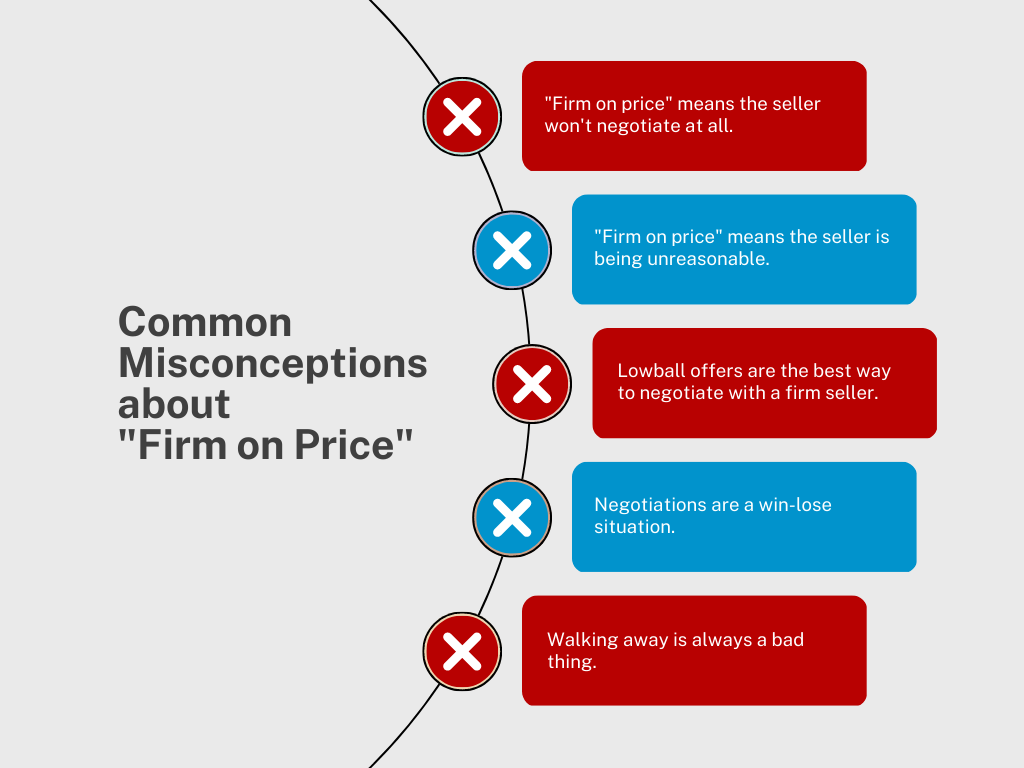Negotiating a fair price is a critical part of any business deal, and it’s not uncommon for both parties to stand their ground during the negotiation process. However, sometimes you may encounter a seller who is “firm on price,” and this can be challenging for the buyer. Understanding the “firm on price” concept is essential if you want to succeed in your negotiations and avoid overpaying for goods or services.
In this guide, we’ll take a closer look at what “firm on price” means and provide some tips for how to handle this situation effectively. Whether you’re a seasoned negotiator or a newcomer to the world of business deals, this article will provide you with valuable insights on how to navigate this tricky scenario.
What is “Firm on Price”
When a seller is “firm on price”, it means that the seller is not willing to accept any lower offers than the listed price for an item. In other words, the seller has set a fixed price for the item, and they are not open to negotiating or haggling over the price. This stance may be due to various factors. In some cases, sellers may use the “firm on price” tactic to test the buyer’s commitment to the deal. The seller may want to see if the buyer is willing to pay the full price or if they will try to negotiate a better deal.
When a seller lists an item on eBay and other best reselling platforms as “Firm on Price,” it is important to read the item description carefully and check the seller’s terms and conditions before making an offer or purchase to avoid any misunderstandings.

Many people assume that when a seller is firm on their asking price, it means they won’t negotiate at all. However, this is not always the case. While some sellers may have a minimum price they’re willing to accept, others may be open to negotiation under the right circumstances.
Some misconceptions about “Firm on Price” negotiations can lead to misunderstandings. Knowing to prevent them can help buyers and sellers reach a mutually beneficial agreement.
How to handle “Firm on Price”
It’s important to maintain a positive relationship with the seller, especially if you may need to do business with them in the future. So if you encounter a listing with “firm on price”, it’s essential to approach the situation with a clear strategy. With the right strategy and approach, it’s possible to find a mutually beneficial agreement.
Getting overly emotional or aggressive during a negotiation can be counterproductive and actually make it more difficult to reach a resolution. So keeping a level head and handling the situation with ease can help you to remain confident and in control. Here are practical tips and techniques for handling “Firm on Price”.
1. Understand the seller’s perspective
Before attempting to negotiate with a seller who is firm on price, it’s essential to understand their perspective. The seller may be firm on price for several reasons:
- High Demand for the Product or Service. If a seller is offering a rare or highly sought-after item, they may be firm on the price, knowing that there is a limited supply of the item available.
- Limited Availability. If the seller has only a few units of a particular product, they may be firm on the price, knowing that they may not be able to replenish their stock.
- Competitive Pricing. If a seller has done their research and determined that their asking price is competitive with other sellers offering similar products, they may be less likely to negotiate.
- Seller’s Confidence in the Product or Service. If a seller has spent time finding reselling products that are high-quality, they may be unwilling to negotiate the price. The seller may feel that their product is worth the asking price and that they cannot afford to lower it.
By understanding the seller’s perspective, you can approach negotiations with empathy and respect. This can help build trust and increase the chances of reaching a mutually beneficial agreement
2. Do your research
Research the fair market value of the product or service you’re interested in and compare prices from different sellers. This will give you a good idea of what a reasonable price is for the product you want to buy.
3. Make a reasonable offer
If the seller is firm on price, it’s still worth making an offer. However, it’s important to make a reasonable offer based on your research. Only make a reasonable offer that is slightly lower than the asking price.
4. Find common ground
Another way to handle a seller who is firm on price is to find common ground. Look for factors that both you and the seller can agree on, such as the quality of the product or service, the seller’s reputation, or the convenience of the transaction. By finding common ground, you may be able to create a more positive negotiating environment.
Negotiating with sellers who are “Firm on Price”
Negotiating with sellers who are firm on their asking price can be a challenging task. It requires patience, strategy, and understanding to reach a fair agreement. To help you navigate these negotiations successfully, here are some tips when negotiating with sellers who are “firm on price.”
- Don’t make lowball offers. This can be disrespectful and damage the negotiation process.
- Don’t be confrontational. Remain calm, respectful, and focused on finding a mutually beneficial agreement.
- Don’t make assumptions. Assuming the seller’s motivation for being firm on price can lead to misunderstandings and prevent you from finding a mutually beneficial agreement.
- Don’t rush the negotiation. Take the time to listen to the seller’s perspective, make a fair offer, and consider adding value to sweeten the deal.
- Don’t be afraid to walk away. If you feel that the seller’s price is unreasonable or unfair, be prepared to walk away.
If negotiations are not successful, it’s worth considering alternatives. You may be able to find a similar product from a different seller who is more willing to negotiate. Alternatively, you may be able to find a different product that meets your needs.

Frequently asked questions about “Firm on Price”
If you still have questions about handling sellers who are firm on their asking price, don’t worry. Here are the answers to some of the most frequently asked questions about negotiating with sellers who are “firm on price.” From understanding the seller’s perspective to making a fair offer, these FAQs aim to provide clarity and insight to help you navigate these negotiations successfully.
1. Can I still try to negotiate with a seller who says “firm on price”?
Yes, you can try to negotiate with a seller who says “firm on price,” but there is no guarantee that they will accept your offer. It is important to take note of the tips mentioned above if the seller is willing to negotiate.
2. Is “firm on price” always a bad thing for buyers?
“Firm on price” is not necessarily a bad thing for buyers. If the price is already fair and the buyer is willing to pay it, then there is no need for negotiation. However, if the buyer feels that the price is too high, then “firm on price” can be a disadvantage.
3. How can I tell if a seller is “firm on price”?
A seller may state that they are “firm on price” in their listing or when communicating with potential buyers. If they do not explicitly state this, you can still ask if they are willing to negotiate the price.
4. What should I do if I am not willing to pay the “firm on price” for an item?
If you are not willing to pay the “firm on price” for an item, you can either try to negotiate with the seller or look for a similar item elsewhere. It is important to remember that the seller is not obligated to accept a lower offer.
Conclusion: Achieving a win-win outcome for “Firm on Price” situations
Dealing with a seller who is firm on price can be challenging, but it’s not impossible to handle. By understanding the meaning of “firm on price” and the reasons why sellers may take this stance, buyers can approach negotiations with empathy and respect. By using the strategies and techniques outlined in this guide, you can navigate these situations with confidence and increase your chances of reaching a favorable agreement.
Ultimately, the key to successful negotiations is patience, professionalism, and a willingness to compromise. Whether you’re buying a product or a service on eBay, these strategies can help you navigate negotiations with a seller who is firm on price and increase your chances of achieving a successful outcome.
If you’re using eBay to buy and resell products, you may want to consider eBay Dropshipping. This model can be particularly appealing for those who don’t have the resources or space to store inventory or for those who want to test out a new product or niche before committing to a large inventory order. Check out this guide of the best eBay dropshipping software to provide you with the best solutions.

